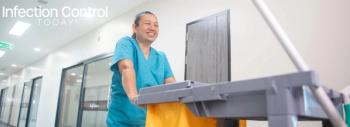
University of Miami Hospital Sets Standard in Patient Care, Low Infection Rates
Contracting an infection is the least desired outcome for a patient during or following a hospital stay. Through the use of a stringent program of training, education and practices, the University of Miami Hospital has achieved and maintained exceptionally low infection rates for 2009.
By Lisa Worley
Contracting an infection is the least desired outcome for a patient during or following a hospital stay. Through the use of a stringent program of training, education and practices, the University of Miami Hospital has achieved and maintained exceptionally low infection rates for 2009. In some instances, the rates at UMH are more than three times lower than the average at teaching hospitals across the nation. The University of Miami Hospital is the only university-owned and operated hospital in the state of Florida.
"We are extremely proud of this accomplishment," says Pascal J. Goldschmidt, MD, senior vice president for medical affairs and dean of the Miller School of Medicine and CEO of UHealth-University of Miami Health System. "Keeping infection rates low is one of the most important patient safety issues and patient safety is our top priority."
The University of Miami purchased what is now the University of Miami Hospital in December 2007, making it the flagship hospital of UHealth.
Hospitals nationwide measure device-related infections, such as those associated with bloodstream infections due to central lines, ventilator-associated pneumonia and urinary tract infections due to inappropriate use and care of a Foley catheter. The National Healthcare Safety Network, managed by the Centers for Disease Control (CDC), collects and reports safety data using standardized methods. The national benchmark for central line infections at teaching hospitals is 2.0. UMH recorded a 0.7 average for all of 2009 -- well below the national average.
Developing an infection means that a patient will stay in the hospital an average of 12 days longer. It is also estimated that each central line infection costs the hospital more than $18,000, which is no longer reimbursed by Medicare.
The national benchmark for ventilator infections is much higher, at 3.3, but UMH kept its rate for 2009 at just 2.0. The same figure of 3.3 is the benchmark for urinary tract infections, where again UMH is dramatically lower, with the average rate at 0.7 for the entire year. Similar to the central lines, a urinary tract infection can lead to a longer hospital stay, more than nine days, and much higher medical costs. Each ventilator infection costs nearly $23,000.
Surgical site infections at UMH for 2009 stand at 1.1 again, significantly lower than the national benchmark of 3.3. With an estimated cost of more than $25,000 and 12 more days in the hospital for each patient, keeping that number down remains a top priority. "We are constantly striving to reduce the amount of time any patient has to spend in the hospital," says Goldschmidt.
Much of the credit for these extraordinarily low rates goes to the stringent protocol established by Anexis Lopez, RN, BHSA, executive director of infection control at UMH. Lopez and her team have established a well-documented system that incorporates education, training and surveillance review on a daily basis. She explains that when a new group of residents or fellows rotates through the hospital, they automatically go through a required orientation that details proper infection control practices at UMH. When infections are identified in patients, attending physicians or surgeons are consulted for a review of the case. "We take a very proactive approach to training each person who might have contact with a patient," says Lopez.
In addition to the training regimen, Lopez attributes the University of Miami Hospitals extremely low infection rates to a daily rounding and surveillance program. Members of the Infection Control Team monitor standards of care and conduct daily audits of intravenous and irrigation solutions, respiratory care equipment and precautionary measures such as patient placement and hand hygiene practices. There is also a pre-screening MRSA program for a selected patient population undergoing surgery as well as critical care patients.
The University of Miami Hospital has daily surveillance rounds for the prevention of central line-associated infections, catheter-associated urinary tract infections and ventilator-associated pneumonia. As Lopez explains, the constant communication between staff and supervisors coupled with follow-up is what leads to success. When there is even just one infection, she says they ask, "How did this happen? What could have been done to prevent this?"
All of the doctors, nurses and staff have been especially alert to rigorous handwashing, and the sanitation staff continues to maintain the highest standards of cleanliness at the hospital. Dean Goldschmidt also praises Anthony Degina, CEO of UMH, for his leadership in this effort.
The daily reviews and rounds lead members of the infection control team to identify potential problems, and implement action plans to avoid possible outbreaks before they happen. "It all goes back to constant vigilance," says Lopez, "and communication among anyone who has contact with patients."
In addition to the practical application of anti-infection measures, the Miller School takes a very proactive role in devising even better ways of enforcing handwashing. David Birnbach, MD, MPH, professor of anesthesiology and director of the UM/Jackson Memorial Hospital Center for Patient Safety, has pioneered innovative methods to train new doctors to be more vigilant in this regard. Working with Jackson Memorial Hospital, UMs teaching hospital, Birnbach has devised an electronic system that detects when a healthcare worker, wearing a sensor, enters a patients room. If that physician or nurse does not wash their hands, an audible reminder is sounded until the proper handwashing takes place. Birnbach hopes to have the technology installed in a pilot hospital room in late summer 2010.
Lisa Worley is director of media relations in the Office of Communications at the University of Miami Miller School of Medicine.
Newsletter
Stay prepared and protected with Infection Control Today's newsletter, delivering essential updates, best practices, and expert insights for infection preventionists.






